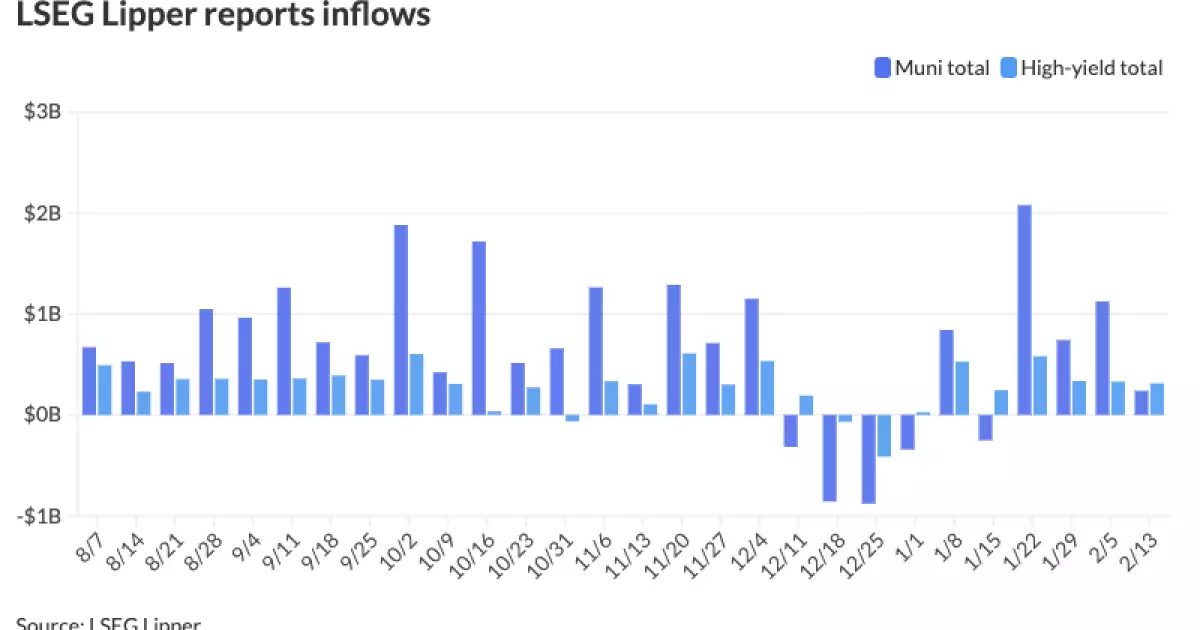As of Thursday, the municipal bond market is experiencing notable firmness, influenced by a rally in U.S. Treasury yields and an uptick in equities. Data from Municipal Market Data reported the two-year to UST ratio at 63%, with subsequent maturities falling slightly behind, highlighting a relatively stable environment for municipal bonds amid overall market fluctuations. The stability in the municipal sector can be attributed to several factors, particularly the possible implications of changing national policies and monetary frameworks. James Welch, a municipal portfolio manager, suggests that the performance and direction of the municipalities in 2025 largely hinge on Washington’s fiscal maneuvers.
This critical nexus between local financial health and federal policy creates a precarious balance, as shifting tax strategies and monetary approaches can pivot the landscape significantly. The impending changes in tax policies, coupled with ongoing debates surrounding budget reconstructions and tariff implications, intensify the scrutiny within the bond market. Yet, despite these challenges, municipal bonds have displayed resilience, managing to absorb shocks stemming from larger economic pressures effectively.
Municipal mutual funds continue to capture investor interest, evidenced by a firm inflow rate over several consecutive weeks. Recently, an infusion of $238.5 million was reported in municipal bond funds, following a significant $1.124 billion influx the preceding week. This trend emphasizes that, although municipal bonds have lagged in performance compared to other assets, investor demand remains robust. High-yield flows, comprising a substantial share of overall fund flows, illustrate an ongoing appetite for riskier classes of municipal bonds, suggesting that investors are not shying away from potential returns in the face of a challenging environment.
Welch points out that there are considerable cash inflows from retail investors, not just through conventional mutual funds but also via exchange-traded funds (ETFs) and managed accounts. This diversified approach to investments highlights a strategic shift towards municipal bonds as they offer an appealing alternative amidst reduced federal funding from prior administrations. With the issuance figures poised to reach $50.74 billion, a 12.5% increase year-over-year, there’s a clear mandate for municipalities to tap into the bond market to address pressing financial needs.
Challenges Ahead for Issuers
However, municipalities face various hurdles, specifically concerning deferred maintenance issues that have persisted due to stalling pandemic-era funding avenues. With federal support dwindling, many entities must confront the limits of their financial resources, prompting immediate action to accommodate urgent projects. Welch’s remarks about municipalities’ speed to the market suggest a sense of urgency, as competition for finite resources intensifies.
This pressure is likely to drive increased activity in the municipal bond issuance space, where the number of projects vying for financing is quickly outpacing available funds. It’s apparent that municipal leaders must engage proactively with investors to drive funding for these imperative projects. The healthy appetite for municipal bonds, despite their performance lag, reflects a calculated risk acceptance that could well serve to stabilize the sector moving forward.
The landscape of investment has dramatically shifted, particularly with the growth of electronic trading and SMAs (separately managed accounts). In the past year alone, there has been a sharp rise in e-trading adoption within the municipal bond market, suggesting an innovative tilt towards more automated and sophisticated investment strategies. Currently, e-trading now accounts for nearly 18.4% of notional trading volume, marking a slight increase from previous years.
This technological adaptation has not only increased transaction volume but has also democratized access to municipal bonds among high-net-worth individuals who may have previously been sidelined. Automated management services facilitate smoother operations, allowing for investment portfolios to be rebalanced with minimal human intervention. This shift signals an encouraging trend towards efficiency in municipal investing that could lead to increased participation and further funding flows into the market.
Looking forward, the municipal bond market seems poised for a period of transition marked by substantial opportunities amid potential pitfalls. Challenges related to policy changes and financial pressures on municipalities will undoubtedly shape the market’s dynamics in the coming years. However, with steady inflows and record volumes of trading, the high demand for municipal bonds, driven by yield attractiveness and innovation within the trading space, suggests a bright future.
Investors and bond issuers alike are tasked with navigating this evolving landscape, marked by both uncertainty and potential growth. This dual narrative encapsulates the essence of the current municipal bond market, painting a picture that is both nuanced and ripe with possibilities. The interaction between local and federal influences, coupled with innovative investment mechanisms, will likely sculpt a new framework for municipal finance in the months and years ahead.

